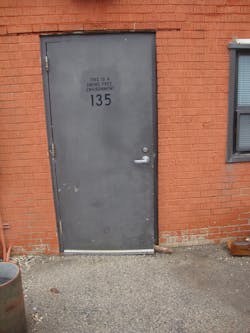Editor’s note: “Mitigating Mistakes” is a new SecurityInfoWatch.com column series from security consultant and author Paul Timm featuring photos of security vulnerabilities discovered in the field followed by a discussion on the problems they present to a facility’s security posture and how they can be addressed.
Exterior door props are probably the most common vulnerability I encounter while conducting physical security assessments. In fact, I have catalogued an ever-increasing array of propping devices (wood wedges, bricks, chairs, rocks, ropes, etc.) in a PowerPoint presentation I call “Im-PROP-er Access Control.” Photos of these propping devices elicit knowing laughs and head nods of commiseration.
Problem: Most security incidents occur due to a failure to control access. Door props can permit unauthorized access and render electronic access control systems valueless. Even visible propping devices that are not currently in use advertise the nearby door(s) as a potential point of unauthorized access. Propping devices also reduce the life span of door hardware as they introduce strain and torqueing issues.
Lesson: Make access control a priority. Do not permit your staff to trade security for convenience.
Remedy: Provide routine staff instruction in access control practices. Informed staff members are more likely to make personal investments in your security program. Require designated individuals, such as facilities personnel, to walk the perimeter of your building(s) at least twice each day. Propping devices encountered should be reported, recorded and removed. You can also install door position switches that will issue a notification if a door has been open for a designated amount of time. Are your access control measures being compromised by door propping? A perfect solution may not exist, but risk-reducing options abound.
About the Author:
Paul Timm, Vice President of Facility Engineering Associates, is a board-certified Physical Security Professional (PSP), the author of School Security: How to Build and Strengthen a School Safety Program, and a nationally acclaimed expert in physical security. In addition to conducting numerous vulnerability assessments and his frequent keynote addresses, Paul is an experienced Crisis Assistance Team volunteer through the National Organization for Victims Assistance (NOVA). He is certified in Vulnerability Assessment Methodology (VAM) through Sandia National Laboratories and the ALPHAÔ vulnerability assessment methodology. He is also a member of ASIS International’s School Safety & Security Council and the Illinois Association of School Business Officials’ Risk Management Committee. Paul recently earned his Master’s degree from Moody Theological Seminary.
About the Author

Paul Timm, PSP
President, RETA Security, Inc.
Paul Timm, Vice President of Facility Engineering Associates, is a board-certified Physical Security Professional (PSP), the author of School Security: How to Build and Strengthen a School Safety Program, and a nationally acclaimed expert in physical security. In addition to conducting numerous vulnerability assessments and his frequent keynote addresses, Paul is an experienced Crisis Assistance Team volunteer through the National Organization for Victims Assistance (NOVA). He is certified in Vulnerability Assessment Methodology (VAM) through Sandia National Laboratories and the ALPHA vulnerability assessment methodology. He is also a member of ASIS International’s School Safety & Security Council and the Illinois Association of School Business Officials’ Risk Management Committee. Paul recently earned his Master’s degree from Moody Theological Seminary.
